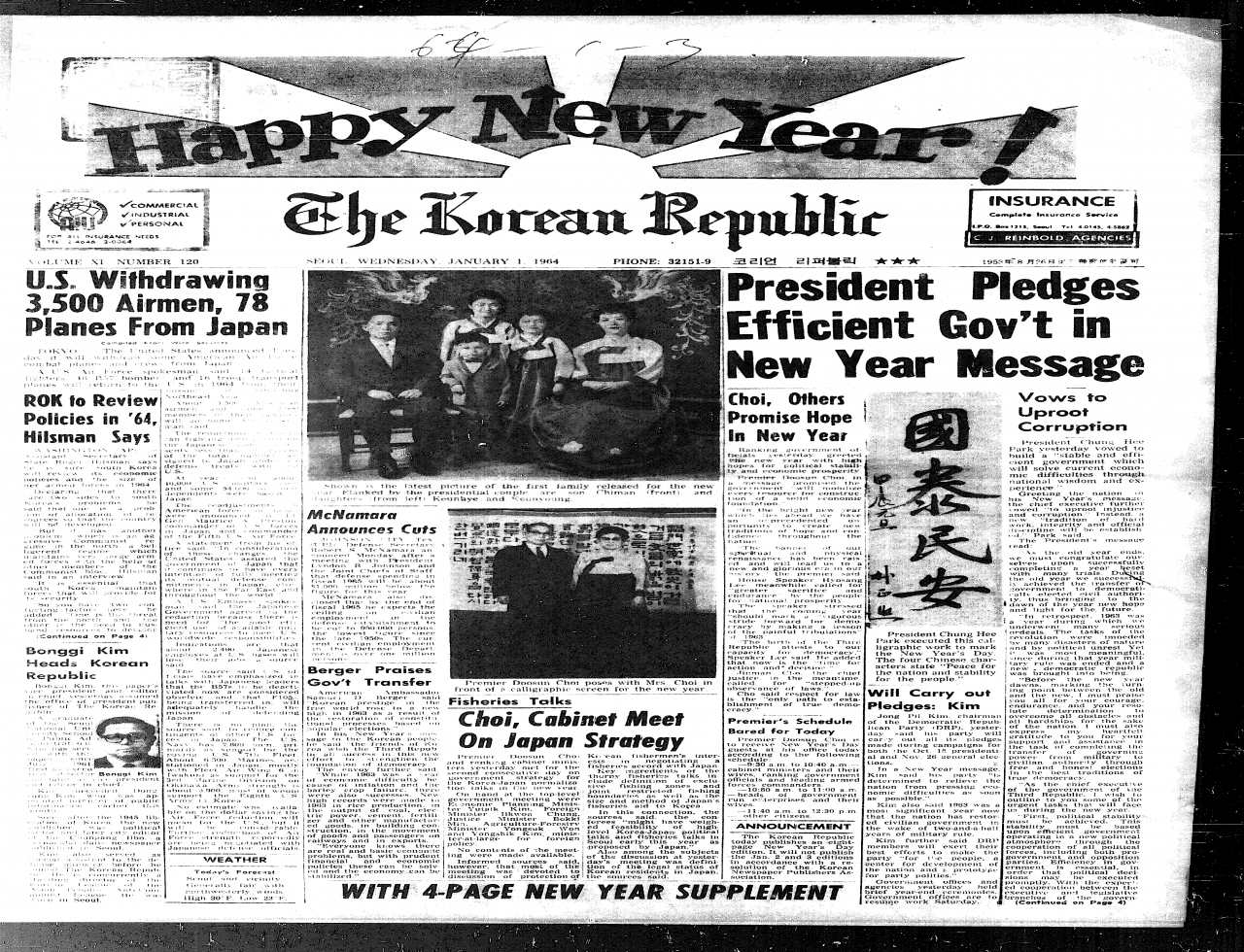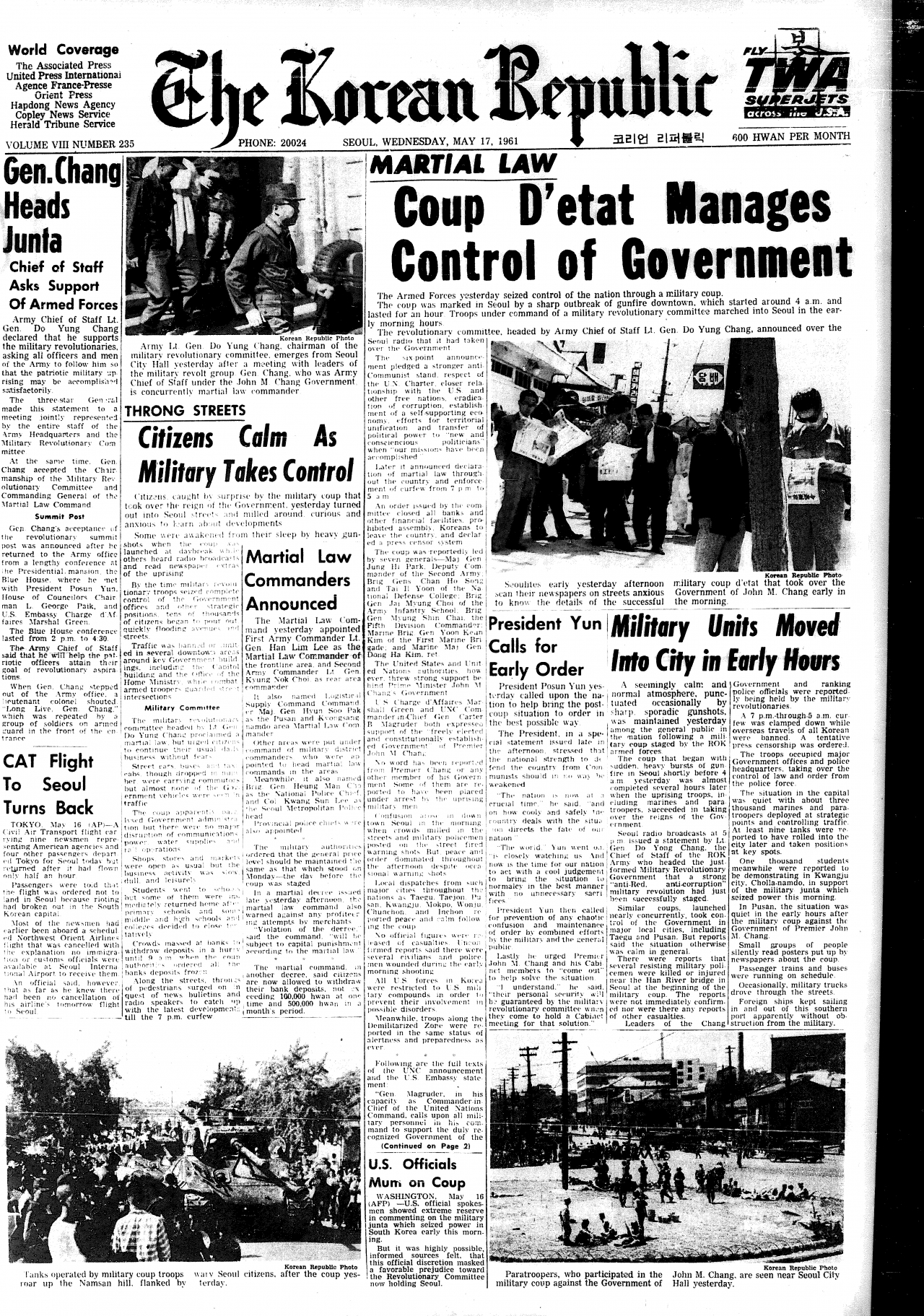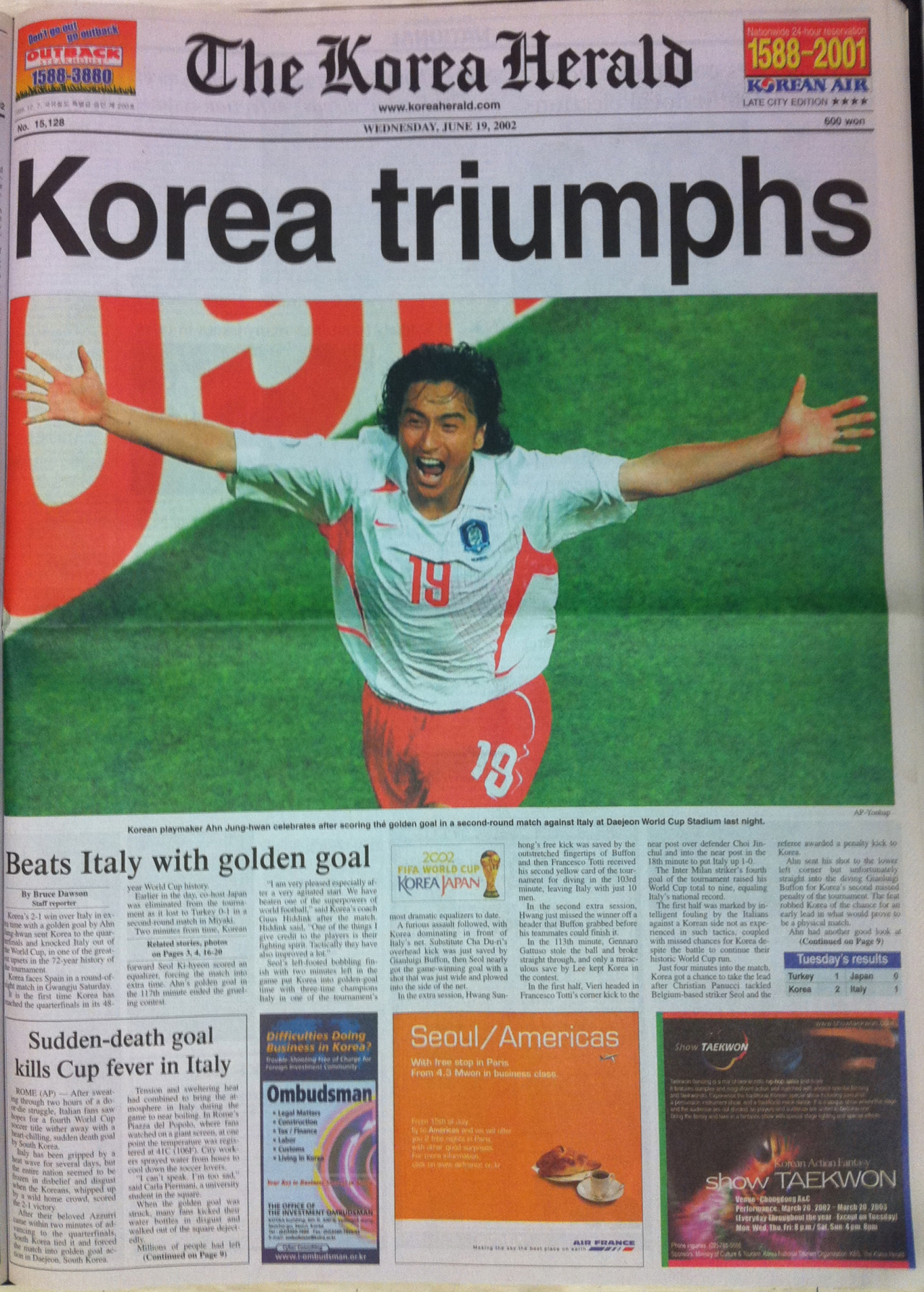[Korean History] 70 years and growing: Korea Herald's legacy and beyond
Born from the ashes of the Korean War, the Herald has been recording history for seven decades
Published : 2023-01-02 10:01:40
Before there was The Korea Herald, there was The Korean Republic.
On Aug. 15, 1953, a four-page tabloid began publication with a mission of telling the world South Korean stories from South Koreans’ perspective.
For a small, impoverished nation that was just setting out to rebuild the ruins of the war, the world was a hostile place, where superpowers -- the US and the now-defunct Soviet Union -- dominated the global agenda and the voices of smaller countries were too often muffled even when their own fate was at stake.
“The fundamental purpose of The Korean Republic is to serve as a dependable source of world news for our readers in Korea and of Korean news for the foreigners in our minds and for our readers abroad,” the paper declared in its first-ever edition.
Behind the newspaper’s birth was none other than South Korea’s founding President Syngman Rhee. A US-educated man himself, he even thought about how to name the new newspaper, which was published by the state-run Korean Information Service.
According to Gal Hong-gi, the first chairman of the state-run Korean Information Service, Rhee had wanted it to be called “The New Republic.” But after finding out that a left-leaning magazine in the United States was already using it, the leader gave his approval to Gal’s suggestion.


The Korean Republic had a humble beginning, with a staff of just three reporters, a managing editor and one photographer. But it stood out in terms of technology by using the first Linotype machine to be brought into country for typesetting.
True to the paper’s founding purpose, the editorials of the paper focused on presenting South Korea’s standpoint to the world. In “What Koreans want,” a five-piece series on the opinion page published in September 1953, the editors wrote that South Korea yearned for unification and freedom for everyone on the Korean Peninsula.
Lee Seon-yeong, a former visiting professor at the department of school of communication arts at Handong Global University, analyzed the columns published in the first year of The Korean Republic to find that the paper was vocal about the diplomatic role of South Korea in relations to the US, Japan and North Korea.
In his paper “Diplomatic role of English-language Newspaper,” Lee wrote that English newspapers were used as an important tool to notify the outside world of the situation in South Korea and where the country stood on various international issues. Of the 290 Korean Republic editorials, 25 percent were about anti-communism, 15 percent on South Korea-Japan relations, 14 percent on South Korea-US relations, and 30 percent were about other international relationships and issues. Just 16 percent talked about domestic topics.
The Oct. 17, 1955 editorial titled, “Where Korea stands.” emphasized that the country must stand against the “Communist armed forces or subversionists, or both,” saying that there was no compromise or middle ground.

Chaotic post-war years
The newspaper has followed the nation throughout its tumultuous history.
The April 27, 1960 edition showed Seoul citizens taking to the streets to demand that then-President Rhee step down. The political turmoil sparked by controversial moves by the Rhee administration to stay in power had led to nationwide protests, eventually resulting in Rhee’s resignation.

“Thousands jam streets in new demonstration,” read the headline. The next day’s edition carried a photo of the protesters cheering upon learning that the president had announced his resignation.
On May 16, 1961, South Korea was thrown into political turmoil as then-Major General Park Chung-hee led a military coup against the government led by the country’s second President Yun Po-sun. The ensuing chaos was reflected in the headline for the May 17 edition of The Korean Republic, “Coup d’etat manages control of government,” along with the news about the declaration of the martial law and President Yun calling for order.

Park would eventually take helm of the country by winning the presidential election by the slimmest of margins just two years later, the news of which the newspaper carried with a headline “Park squeaks by Yun.”
The Jan. 1, 1964 edition of The Korean Republic carried a photo of what would eventually be the photograph of two South Korean presidents; the family photo of then-President Park, including his oldest daughter Park Geun-hye. The junior Park would be elected the leader of the country in 2012.
Of course, the newspaper had more issues to talk about than the Park family. The first page showed that the prime minister at the time, Choi Doo-sun, met with the Cabinet for talks concerning government strategy on normalizing relationship with Japan, with whom the country had been at loggerheads since its 1910-1945 colonization of the Korean Peninsula.
One year later, the newspaper announced on its Aug. 15 anniversary edition the name change to The Korea Herald. In regards to the aforementioned talks with Japan, the paper showed that the accords to set up formal ties with Japan had been ratified by the National Assembly, and that the South Korean government had expressed hopes that it would “promote prosperity” of the country.

Looking through the faded pages of The Korea Herald, one could witness the turbulent path that S. Korea has gone through to reach where it stands today: from the nationwide mourning in 1974 for Yuk Young-soo, the first lady to former President Park, who continued his iron grip on the country 16 years, the plight of the May 18 pro-democratization movement against military strongman Chun Doo-hwan in 1980, to North Korea’s unsuccessful assassination attempt on Chun in the present-day Yangon, Myanmar, known as the “Rangoon Bombing.”
Until the late 1980s, the country's political climate was marked by government crackdowns on pro-democracy movements and strict censorship on the media.
This is shown in the April 21, 1960, edition of The Korean Republic which had been heavily censored by the authorities. One photo and the accompanying caption has been completely modified to the extent that the content of the photo can no longer be made out.
Changes for the Herald
In addition to covering the historical events around the country, the newspaper itself underwent major changes in the 1970s and 1980s. In a bid to create a newspaper that would “allow the reader to obtain information and knowledge about the world market,” in the words of an economic adviser for Ex-President Park Chung-hee, the government and the Korea International Trade Association co-founded the Naeway Economic Daily in 1973, which would later change its name to The Herald Business.
KITA’s acquisition of The Korea Herald in 1978 had made Naeway a sister company to the English newspaper, a relationship that persists to this day.

But the late 1970s and early 1980s were marked by instability, with Park’s assassination in 1979, and his successor Choi Kyu-hah’s administration being overthrown by another military general, Chun Doo-hwan. Chun’s junta attempted to tighten its grip on the country by controlling the media, resulting in 1,000 reporters being sacked and 64 news outlets -- including Naeway Economic Daily -- being shut down or merged in November 1980.
In 1989, Naeway was revived and Dainong Corp., a now-defunct textile maker, became the new majority shareholder of the two newspapers. As a result, The Korea Herald’s ownership was transferred from the government to the private sector for the first time since its creation.
Herald in the late 20th century
Surviving the media purge, The Korea Herald carried on with the news of South Korea’s rapid economic growth and rising status in the international stage. The top news for the Oct. 1, 1981 edition was “IOC picks Seoul as venue for '88 Summer Olympics: ROK (Republic of Korea) first developing country to host Games,” showing that the nation’s capital beat the Japanese city of Nagoya 52-27 in the vote.


The Korea Herald on July 3, 1983 carried news of the KBS telethon that reunited over 300 families that had been separated by the Korean War. The campaign by the state-run broadcaster was aired live from late June throughout November, with abundance of teary reunions and memorable episodes that were talked about for years to come.
The following year, the Sept. 29 edition of The Herald shows that South Korea celebrated the opening of the Seoul Olympic Stadium in Jamsil, southern Seoul, which was to be the site of the 1986 Asiad and the 1988 Summer Olympics. Festive atmosphere that filled the country was demonstrated in the front page of the Sept. 18, 1988 edition, where The Herald celebrated South Korea’s first Summer Games with the headline “XXIVth Olympiad begins.”

The Dec. 1, 1987 edition carried some truly grim news. “KAL (Korean Air) plan crashes on Thai-Burma border; all 115 aboard feared dead,” the headline read.
The ominous forecast turned out to be accurate. The crash was the result of a bombing by two North Korean agents. They attempted suicide after being arrested but one of them -- a woman by the name of Kim Hyon-hui -- survived and later confessed to the crime. She was sentenced to death but subsequently pardoned by the Roh Tae-woo administration.

The terrorist pinpointed Kim Jong-il, then the heir to the dictatorial regime of North Korea and eventual leader of the hermit kingdom, as the main culprit behind the bombing, but the communist country denies its involvement to this day.
While the two Koreas had been butting heads for much of the 20th century, there was a hint that the two rivals may be headed in a different direction in the Sept. 18, 1991 edition. The top news of the day was “South, North Korea join U.N.,” with the sub-headline “A new beginning to remove last vestiges of Cold War.”

A Korea Herald correspondent at the United Nations headquarters in New York reported that the UN General Assembly adopted a resolution on their membership by consensus, along with five other nations.
Just a year later on the Aug. 25, 1992 edition, the newspaper told of how South Korea and China set up diplomatic ties, “ending four decades of Cold War enmity.” The communist China and the Soviet Union supported the North Koreans in the Cold War, while South Korea was backed by the US and the allied countries of the UN.
The rapid growth of South Korea was not without some hiccups and the deadliest came in 1995. The June 30 edition of The Korea Herald tells of a disaster that struck in downtown Seoul via the headline “Hundreds buried, 30 dead in collapse of Sampoong Department Store.”
Unfortunately, most of the buried victims died. With 502 dead and 937 injured, it remains the largest peacetime disaster in South Korean history.

Recording a day in history
In June 2000, the heads of South and North Korea met for the first time since the two Koreas established their separate governments in 1948. The Korea Herald commemorated the meeting with the headline, “A day to be recorded in history,” in the June 14 edition with a photo of then-President Kim Dae-jung meeting North Korea’s former leader Kim Jong-il -- both of whom are now deceased.

As part of the joint press corps that traveled to the North Korean capital of Pyongyang, reporters from the Herald told the world of how the two Kims from the two Koreas agreed to set up inter-Korean hotlines, and how the South Korean leader received an “unexpectedly hearty” welcome from the North Koreans. Kim Dae-jung’s Berlin Declaration in March that year, which declared how South Korea will expand support for Pyongyang and increase cooperation with the North, led to the aforementioned summit, and the inter-Korean relations took a new turn in the 21st century.
But it was not all roses in the new century, as the communist country’s unexpected actions and provocations continued to provide hurdles. This included Pyongyang’s withdrawal from the Non-Proliferation of Nuclear Weapons Treaty and subsequent development of its nuclear programs, along with continued pursuit of long-range ballistic missiles.
Such tension is indicated in the May 30, 2009 edition, which says “North Korea fires new type of missile off east coast,” citing government officials on how the communist state launched a short-range missile from its Musudan-ri rocket launch site. In the Nov. 24, 2010 edition, the top story was how “N.K. artillery strikes S. Korean island,” the article on the bombardment of Yeonpyeong island by the North Koreans that killed two South Korean marines and two civilians in the island.

The North’s military belligerence has been more profound than ever this year, as it launched at least 65 missiles this year -- including intercontinental ballistic missiles -- more than during any other year.
The top story for the aforementioned 2009 edition, however, was “Nation bids farewell to President Roh,” covering the national mourning for former President Roh Moo-hyun. A magnet of controversy with a flamboyant personality and brash words, the former leader of South Korea had jumped to his death the week before amid bribery scandals involving his close aides and family members. The intense crackdown on Roh under then-President Lee Myung-bak had sparked disputes about the conservative administration's supposed “political oppression” of Lee's predecessor.
Outside of deaths and North Korean provocations, South Korea had plenty of memorable occasions that are etched across the pages. Among Koreans’ favorite sports moments in history the national soccer team's ascent to the semifinals of the 2002 World Cup, told in the June 19, 2002 edition’s top story titled simply, “Korea triumphs.”

It is accompanied by a photo of South Korean striker Ahn Jung-hwan cheering after his golden goal in the Round of 16 that took down the championship contender Italy. The World Cup fever since then has also been covered by the Herald staff reporters, including the nation’s shocking upset of Portugal this year in Qatar that resulted in its third trip to the knockout stages in history.
Other memorable news in more recent history includes: the election of South Korea’s first female president, Park Geun-hye in 2012, the successful launch of its first locally-assembled space rocket in 2013, the sinking of the Sewol ferry that left 304 dead or missing in 2014, Park becoming the first South Korean president to be successfully impeached in 2016, her successor Moon Jae-in’s summit with current North Korean leader Kim Jong-un and their ultimately unsuccessful attempt to declare end to Korean War, and this year’s deadly crowd crush in Itaewon that left 158 dead.
Whether it be the now-yellowed pages of the Korean Republic, the gray pages of the early Korea Herald editions, the apricot-colored pages since 2005, or the modern designs since the 2012 overhaul of the newspaper’s layout, the stories covered by The Korea Herald recorded Korea’s turbulent path from a war-torn country to where it stands now, true to its founding purpose 70 years ago to act as a window between the Korean Peninsula and the outside world.
Since its birth in 1953, The Korea Herald has functioned as a window between South Korea and the outside world.
The upcoming series “History through The Korea Herald” will revisit significant events and issues over the seven decades through articles, photos and editorial pieces published in the Herald and retell them from a contemporary perspective. – Ed.
http://www.koreaherald.com/common/newsprint.php?ud=20230101000126